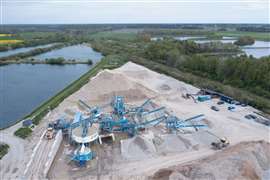In the heart of the city
27 November 2014
The work that gained Keltbray this award covered buildings formerly known as 169 to 189 Regent Street, No’s 1, 2, 3 & 4 New Burlington Street (NBS) and No’s 2, 3 & 4 New Burlington Place (NBP), with a single basement extended over the entire site. The 10 buildings on site were generally constructed in the early 1900s and were extensively altered during the subsequent 80-100 years.
The project required the Regent Street and NBS façades below the cornice levels to be retained, while No’s 1 and 2 were to be retained in their entirety due to their Grade II listing.
After taking possession of the site extensive surveys were undertaken to understand the existence of services, asbestos, and other hazardous materials.
During the design of the façade retention scheme, extensive meetings were held with the Westminster City Council (WCC) highways team to gain agreement to excavate the surrounding pavements. The excavations, once complete, would establish the position of all buried services and in turn allow the in-house temporary works design engineers to position the foundations of the façade support towers. In addition to the location of the buried services the designers also had to contend with the position of the nearby London Underground system, the Bakerloo line tunnels pass underneath Regent Street approximately 8 m (26.3 ft) from the façade, with the crown level of the tunnel approximately 21 m ((69 ft) below pavement level.
The excavations had to be done in accordance with the WCC guidelines but also be sympathetic to the normal functioning of a very busy city pavement and tourist area.
The client’s engineer façade retention design intent asked for two support towers along the Regent Street elevation and the NBS elevation. Due to the extensive quantity of services within the pavement Keltbray and its in-house temporary works engineer were able to value engineer this system to one support tower along the Regent Street elevation by relying on the adjoining structure
Meanwhile works had begun to form the access/egress entrance to service the project, along with the early asbestos removal and soft strip to the basement areas and the inner courtyard area. During the key phases, the site had day and night shifts in operation undertaking façade retention, Portland stone dismantle, high level structural demolition, erection and dismantle of demolition scaffolding, erection of Mason scaffold, installation of welfare accommodation on the façade retention steel frame, basement enabling works and soft strip, all through one entrance.
High level cantilevered scaffold was installed to enable high level demolition works, stone dismantling and lead work salvage early on in the programme while the façade retention piling and existing foundation removal works progressed at basement and ground level concurrently.
The demolition specification only permitted the use of one entrance onto site. In normal circumstances a site entrance would usually be formed where the façades are not being retained. However, in this case the non-retained façade was directly opposite TCEs offices, so the only other position available was along the NBS façade through an existing shop front.
Following swept path analysis of the types of construction vehicles required to service the project, the shop front at 4 NBS was selected as the only possible usable entrance. To ensure this location would work, further detailed site investigations were undertaken to establish the construction of the basement and ground level structure. Keltbray’s temporary works engineers provided a scheme that involved the installation of over 300 acrow props to support the existing ground floors, installing 150 m2 (1,615 ft2) of steel plates to protect the existing ground floor, installation of a temporary bridge structure spanning the existing light well between the pavement and shop front and finally the excavation and construction of a concrete slab (crossover) to protect the existing services within the pavement.
With the above key works complete the site team were able to take delivery of the plant to undertake the first element of demolition to the rear low level courtyard structures, however with the restricted height clearance of 3.7 m (12.2 ft), the type and size of plant was limited.
In addition to the site constraints, NBS was reduced to a single carriageway due to another construction site being directly opposite using a pit lane to service that site. From the offset agreements were put in place to ensure the section of the pit lane directly opposite the Keltbray site entrance was kept free at all times allowing access/egress to W5. However to ensure these agreements were maintained, weekly and daily coordination meetings were held between the site construction teams.
Once the low level demolition was complete the site team could focus on the next key resources for the successful delivery of the project, the demolition tower crane and the foundations for the façade retention system.
The tower crane was designed to be free standing, with coverage over the whole site. In planning the tower crane erection, Keltbray and HTC were restricted to only using NBS for the position of the erecting mobile crane. The position of this within NBS also had to contend with the external scaffold and hoarding of the W4 project, so the erecting mobile crane selected was a 250 tonne with fly jib to reach over the existing buildings. The foundations for the façade retention were all designed as reinforced concrete, with 20 300ᶿ piles at 22 m deep. With the tower crane erected and sufficient foundations cast the erection of the façade retention commenced, three months from taking possession of the site.
Deliveries of the façade retention steelwork had to be carried out between 5 and 6 am. The initial phase of the façade retention had to be undertaken duration night shifts, reducing the interface with the general public as the first sections of the steel work penetrated the pavement zone. These were also restricted to six hours per night and only four nights of the week.
Once the steel frame had passed the pavement zone with protection afforded to the public, the façade retention installation continued during normal day shifts, however still with the occasional night time working where interface with the public existed (the façade retention system weighted in at 130 tonnes).
To progress the Portland stone façade and stone dormer dismantling works above the 5th floor cornice as early as possible in the programme, Keltbray designed and installed a cantilever scaffold at 4th floor to support the access scaffold required to gain access to the façades being dismantled.
Another reason why Keltbray won the tender was their ability to advance much of the future groundworks during the demolition phase of the project. The groundworks involved the removal of the existing basement structure and foundations at the location of the mini piles. Installation of 40 450ᶿ piles at 22 m deep complete with vertical steel beams (known as kingposts), a 3 m (9.8 ft) reduced level excavation with construction of concrete wall panels between the king posts, and 40 m (131.2 ft) of 3 m deep underpins.
To maintain the high profile of the project TCE instructed the design, and installation of a wrap to cover the outside of the façade retention steel frame along the Regent Street and NBS elevations, an additional secondary steel frame was designed and erected to the existing main support steel to ensure the wrap was in straight line and level.
Due to the high cost of the wrap, façade movement monitoring could not be carried out externally since this would have required holes to be cut in the wrap to view the targets. The basement line monitoring was done prior to the installation of the wrap but the remaining monitoring could only be carried out from inside the project of the working floors in and around the demolition works. Rotating targets were installed to the reveals of the existing windows to allow view externally for the basement line and then internally during the works.
Once the façade retention steel frame was installed and signed off and the Portland stone and the high level roof demolition works were completed the main structural demolition commenced from the 5th floor level down to the existing basement level.
CONNECT WITH THE TEAM








